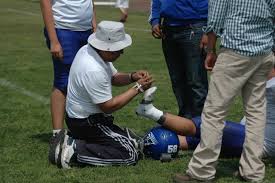Main Menu
Latest Blog Entry
User login
PRICE Guidelines for injury treatment
Current recommendations on treating injuries
After witnessing the aftermath of the parents’ races at my daughters’ school sports day last week, I decided to review the current Executive Summary of the Management of Acute Soft Tissue Protection, Rest, Ice, Compression and Elevation (PRICE) by the Association of Chartered Physiotherapists in Sports and Exercise medicine (ACPSM).
 The previous recommendations by the ACPSM were made based on evidence published up to 1996. These current clinical guidelines, which I have summarised below, were produced by a team of volunteers using evidence up to 2010. Each PRICE intervention has been graded as STRONG, WEAK or UNCERTAIN.
The previous recommendations by the ACPSM were made based on evidence published up to 1996. These current clinical guidelines, which I have summarised below, were produced by a team of volunteers using evidence up to 2010. Each PRICE intervention has been graded as STRONG, WEAK or UNCERTAIN.
PROTECTION AND REST (STRONG)
“Definitely unload soft tissue in acute phases after injury”. WHY?
- Minimise internal bleeding
- Prevent excessive swelling
- Prevent re –injury
The type and duration of the protection /resting phase is not clear and will depend on the specific injury and its severity.
Progressive and mechanical loading plays a vital role in tissue healing. The transition from this protective stage needs to be supervised by a Physiotherapist.
ICE (STRONG)
“Definitely apply ice after an acute soft tissue injury.” WHY?
Cooling the tissues…..
- Can limit the extent of the soft tissue injury
- Provides pain relief
- Can facilitate rehabilitation
The guidelines suggest that crushed ice in a bag which is wrapped with a ‘damp barrier’ i.e. damp cloth or tea towel is applied to the area for 5 – 15 minutes every 2 hours.
During sporting events, application of ice for > 10 minutes can have an adverse effect on athletic performance and increase injury risk.
COMPRESSION AND ELEVATION (WEAK)
 “Probably use compression/elevation after an acute soft tissue injury”. WHY?
“Probably use compression/elevation after an acute soft tissue injury”. WHY?
- to limit tissue swelling
- can reduce pain due to increased tissue pressures
Evidence is poor to support the use of elevation and most of the research is conflicting regarding the use of compression.
The guidelines conclude, “Probably don’t use high levels of compression with simultaneous elevation.”
If compression bandages or external supports are used they must fit well. They can offer some support and give confidence to the injured when returning to normal function.
Always consult with a Physiotherapist or an appropriate medical professional after a significant soft tissue injury.
Sarah Marshall
Client Testimonials
 London Welsh RFC
London Welsh RFC
James has provided a wealth of experience and expertise to the Academy set up at London Welsh RFC in recent years. He has addressed both the physical and mental development of the players through innovative, player and position specific programmes which have resulted in each individual within the group developing towards their potential.
More


Comments
[…] Accumulation: Something all coaches should think about, young athletes are likely to be playing several sports leading them to train more than professional athletes, this can result in fatigue, stress and injuries. […]